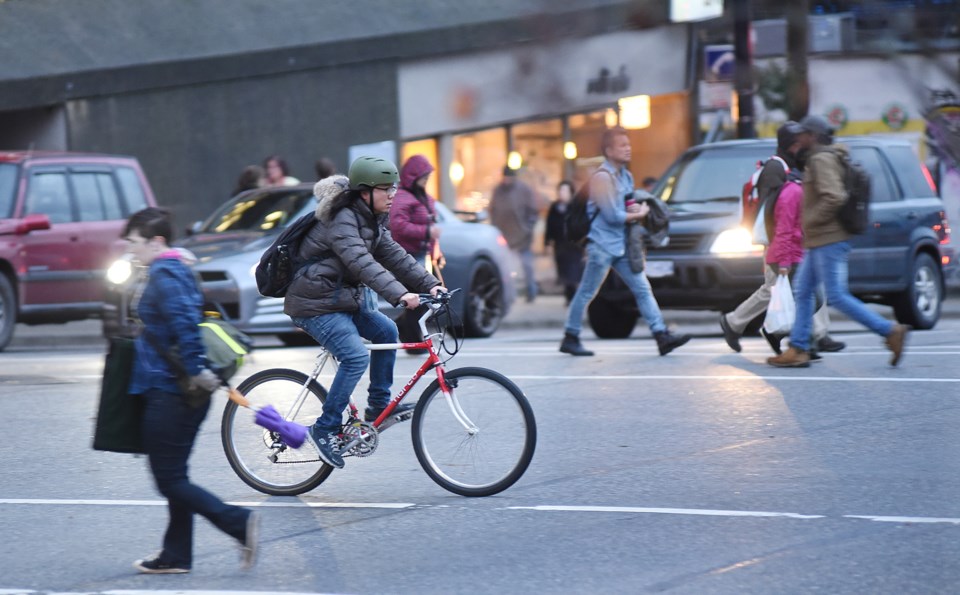Winter has reared its ugly head in Vancouver. Days are shorter and wetter, and the evening rush hour takes place in near pitch-black conditions.
As in seasons past, the usual safety campaigns from ICBC and the VPD have emerged. Frustratingly for us, we read on the topic focuses on how pedestrians and cyclists need to take responsibility for their own safety.
Conversely, very little time is spent reminding drivers that — as operators of fast-moving, two-tonne machines — a single moment of carelessness, impatience or distraction could be the difference between life and death for more vulnerable road users.
We will readily admit there are some measures pedestrians and cyclists simply must take to ensure their safety. For example, it just makes sense — and it’s the law — to ride a bike equipped with front and rear lights, and — as cyclists ourselves — we are just as frustrated with those who overlook this simple and inexpensive equipment when riding after dark. There are other basic laws and, of course, it only makes sense to check both ways before crossing the street, as parents teach their children.
We begin to disagree with the hyper-focus on staying visible. For example, from ICBC: “Dress to be seen. Wear reflective clothing or gear and flashlights to make it easier for drivers to see you.”
Sure, it’s difficult to see someone dressed all in black. However, if a motorist is approaching a crosswalk or intersection, shouldn’t the onus be on the driver to travel at an appropriate speed and look out for anyone waiting to cross? How many of us are actually walking with a flashlight in our pockets for evening strolls? Is it not dangerous to flash a beam of light into a driver’s eyes?
Admittedly, if everyone getting around by foot or bike dressed like a Christmas tree, they would certainly be more visible. The question is: would that stop a careless driver from hitting them?
ICBC’s own data suggests it wouldn’t.
About three-quarters of all pedestrian-car collisions take place in a designated intersection or marked crosswalk, with the pedestrian having the . The fact is that unless we start putting more pressure on drivers to slow down, pay attention, and drive responsibly, we don’t believe any amount of reflective or safety gear will protect more susceptible road users from being struck.
We recently spent some time in New Zealand, a place where pedestrians and cyclists have even fewer rights than here. Crosswalks rarely exist outside of major intersections; meaning pedestrians must always yield to motor vehicles, unless they have a signaled crossing.
There is one message we kept hearing from those working to improve conditions there, and it’s something we need to recognize here: No matter what, at some point in our journey, each of us is a pedestrian. When we reach our destination by bike, car, train or bus, we all walk the remaining distance.
No one asks drivers to wrap their cars in , or dress in bright clothing (even though at some point they will travel by foot). By that logic, we all know what it’s like to be a pedestrian.
Some countries are getting it right, and perhaps we should look to places like Holland and Sweden for inspiration. , while North America was developing wider, faster roads, engineers recognized that by simply slowing down traffic and designing narrower streets, motorists were forced to pay more attention.
Perhaps it’s time ICBC and the VPD take a serious look at our city’s — which places the humble pedestrian at the top, and private automobile at the bottom — and realize the best way to reduce collisions is not by placing the bulk of responsibility on the victim.
Instead, we believe this must be done by implementing comprehensive road planning, reducing speed limits on arterials to 30 km/hour — as they’ve recently done in London — and shifting their focus onto harsher punishments for speeding, crosswalk running, and impaired and distracted driving.
We are all human and can all make mistakes from time-to-time, but when walking or cycling, those mistakes are only going to harm you. No number of reflective armbands, flashlights, or high-viz clothing is going to prevent a driver’s (inevitable, we feel) mistake and its potentially fatal outcome.
Melissa and Chris Bruntlett are the founders of Modacity and are inspired to live happy lives of urban mobility. Follow them at .



